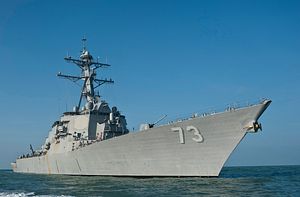New details have emerged about China’s reaction to the Trump administration’s latest freedom of navigation operation in the South China Sea. After a U.S. destroyer sailed within 12 nautical miles of two China-built artificial islands, a Chinese destroyer trailed the U.S. vessel and had what the U.S. Department of Defense is calling an “unsafe” interaction with the U.S. warship.
On Sunday, USS Decatur, an Arleigh Burke-class guided missile destroyer carried out an innocent passage freedom of navigation operation near Gaven and Johnson Reefs in the Spratly Islands. The ship, according to a CNN report, was trailed by a People’s Liberation Army-Navy Type 052C Luyang II-class destroyer.
The Chinese destroyer then “approached USS Decatur in an unsafe and unprofessional maneuver in the vicinity of Gaven Reef in the South China Sea,” according to Capt. Charles Brown, a spokesman for U.S. Pacific Fleet, who released a statement to CNN.
The Type 052C destroyer “approached within 45 yards” of the bow of the Decatur, presumably in a maneuver designed to forcibly stop the vessel’s continued passage. The Decatur had to maneuver “to prevent a collision,” according to Brown’s statement.
The maneuver appears to be the most serious attempt by the PLAN to forcibly interfere in a U.S. freedom of navigation operation in the South China Sea.
Gaven Reefs, which is also claimed by Vietnam, the Philippines, and Taiwan, was first occupied by China in 1988. It is today the site of a small artificial island of 34 acres.
China’s maneuver appears to have been deliberate and unusually provocative. Generally, after the Obama administration began regular freedom of navigation operations in the South China Sea in October 2015, PLAN vessels have trailed and warned U.S. vessels.
On Tuesday, China condemned the U.S. for the latest freedom of navigation operation, saying it threatened its sovereignty. The Chinese Ministry of Defense acknowledged that a vessel was sent to monitor and warn the U.S. vessel, but did not acknowledge the incident described by the Pentagon.
“The U.S. side repeatedly sends military ships without permission into seas close to South China Seas islands, seriously threatening China’s sovereignty and security, seriously damaging Sino-U.S. military ties and seriously harming regional peace and stability,” the ministry said in a statement.
“China’s military is resolutely opposed to this,” it added.
In 2014, both the United States and China, along with 19 other navies, agreed to the Code for Unplanned Encounters at Sea, which governs “professional” practices for navies. Both countries are also signatures to the 1972 International Regulations for Preventing Collisions at Sea 1972 (COLREGs).
U.S.-China ties are heading for the gutter right now. My colleague Shannon Tiezzi has a good readout of other underlying tensions, including those that led to the cancellation of the upcoming security dialogue.
The timing of this latest PLAN-U.S. Navy “unsafe” encounter comes at a time of other tensions in the relationship, including over the ongoing trade war. In September, the Trump administration moved ahead with a $200 billion round of tariffs, with China retaliating with its own $60 billion package of tariffs.

































